Presentation1 on solar system
Download as pptx, pdf0 likes218 views
The solar system contains 8-9 planets including Mercury, Venus, Earth, Mars, Jupiter, Saturn, Uranus, Neptune and possibly Pluto. These planets orbit the sun and make up the main bodies found in our solar system.
1 of 10
Download to read offline


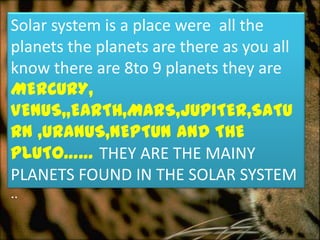
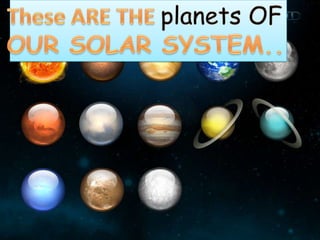
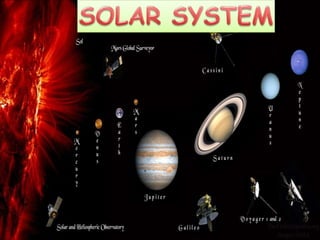
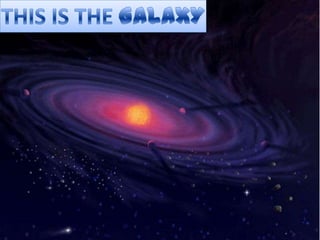
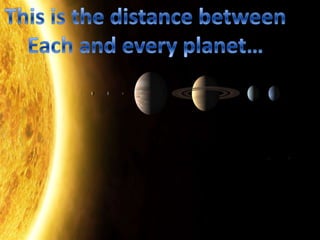
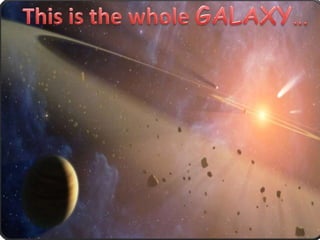


Ad
Recommended
Presentaci├│n planets
Presentaci├│n planetsmariateresagarciaalvarez
╠²
The document describes the 8 planets in our solar system - Mercury, Venus, Earth, Mars, Jupiter, Saturn, Uranus, and Neptune. It provides key details about each planet, noting Mercury is the smallest, Venus is very hot, Earth is the only known place with life, Mars is nicknamed the Red Planet, Jupiter is the largest, Saturn has elaborate rings, Uranus is the 7th planet, and Neptune is the farthest planet from the Sun.In the space alex s
In the space alex snikteixmucane
╠²
The document depicts the solar system with the sun at the center and the eight planets in orbits around it. It lists the eight planets as Jupiter, Saturn, Uranus, Neptune, Mars, Earth, Venus, and Mercury. It also notes that Venus is the hottest planet and Neptune is the coldest planet.In my space by t├Ānia
In my space by t├Ānianikteixmucane
╠²
This document describes the 8 planets in our solar system and any inhabitants on each planet. It notes that Earth has 1 alien waving goodbye, Jupiter has 1 astronaut waving hello, Mars has a rocket going under the planet, Saturn has a satellite going under it, Uranus and Mercury are blue with blue aliens, Neptune is blue and purple with purple aliens, and Venus is brown with brown aliens.In space by bel
In space by belnikteixmucane
╠²
In space there are many stars and four planets - Mercury, Mars, Uranus and Neptune. The sun is a very big and hot star that the rocket circles around while a UFO flies over Mars. On Uranus there are three aliens of different sizes.Cienna corpuz ppt.
Cienna corpuz ppt.sumidahilo
╠²
The document outlines key facts about the planets in our solar system, listing each planet from Mercury to Pluto and their order from the sun as well as their size ranking. It states that Mercury is the closest planet to the sun and the eighth largest planet. Venus is the second planet from the sun and the sixth largest planet. Earth is the third closest planet to the sun and the fifth largest planet.Planets
PlanetsGines Garc├Ła
╠²
The document describes the key features of the planets in our solar system. It notes that the solar system is centered around the largest star, the Sun, and contains 8 planets (no longer including Pluto). It provides 1-2 sentences on each planet, noting their size, color, distance from the Sun, and other distinguishing characteristics like moons or rings.Solar System
Solar System13ngdh1
╠²
The solar system has 8 planets in order from the sun: Mercury, Venus, Earth, Mars, Jupiter, Saturn, Uranus, and Neptune. There were previously 9 planets but Pluto is now classified as a dwarf planet. The inner planets closest to the sun are Mercury, Venus, Earth, and Mars and are rocky with no moons or rings. The outer planets beyond Mars are Jupiter, Saturn, Uranus, and Neptune.In space manuel
In space manuelnikteixmucane
╠²
The document discusses what can be seen through a telescope in space. It mentions the eight planets - Mercury, Venus, Earth, Mars, Jupiter, Saturn, Uranus and Neptune. It also notes that while a telescope can see space, planets and stars, it cannot see UFOs or aliens. However, it is possible to see satellites and rockets traveling between celestial bodies like going around the moon or passing Mars and Jupiter.Pp Our Solar System, Minerva 6th A
Pp Our Solar System, Minerva 6th AÁngela Piedras Urbina
╠²
There are 8 planets in our solar system: Mercury, Venus, Earth, Mars, Jupiter, Saturn, Uranus, and Neptune. Mercury is the smallest planet and closest to the sun. Venus is the hottest planet with thick clouds surrounding it. Earth is the only planet that supports life due to its oxygen atmosphere. Mars has deserts and canyons and is nicknamed the red planet. Jupiter is the largest planet and over 11 times the size of Earth. Saturn has the unique feature of rings visible from Earth. Uranus is named after the Greek god of the sky and Neptune is the farthest and coldest planet from the sun.P5 c science 2
P5 c science 2DIAH KOHLER
╠²
The document provides information about the planets in our solar system, including their order from the sun, basic facts about each planet like their size and notable features, and true/false questions about Neptune and Uranus. It states that Jupiter is the largest planet and Venus has more volcanoes than any other. Neptune is identified as having the most violent weather and being the windiest planet.Neptune
Neptunebetixirimiri
╠²
Neptune is the eighth and farthest planet from the Sun in our solar system. It is the fourth largest planet. Neptune takes just over 24 hours to rotate and approximately 165 years to orbit the Sun. Neptune has at least 8 moons and multiple thin rings around it. It is composed primarily of hydrogen, helium, and water ice. Neptune was the first planet discovered through mathematical calculations rather than direct observation.Solar system
Solar systemMary Ann Pacana
╠²
The solar system consists of the Sun and nine planets: Mercury, Venus, Earth, Mars, Jupiter, Saturn, Uranus, Neptune, and Pluto. The planets orbit the Sun and range significantly in size.Alberto D├Łaz
Alberto D├Łaz Chasedi
╠²
This document discusses various space-related topics, including that Neptuno is the coldest planet, the galaxy is very big, an astronaut plays guitar on the moon, aliens live on Mars, there are eight planets in the universe, satellites orbit Earth, and a UFO flies under Earth. The document was created by Alberto Diaz Perez.The Solar System
The Solar Systemweixinl
╠²
The Solar System consists of 8 planets that orbit the sun. The inner planets are Mercury, Venus, Earth, and Mars. Mercury is the closest planet to the sun and experiences extreme temperature changes. Venus is similar in size to Earth but has a dense, hot atmosphere. Earth is the only known planet capable of sustaining life. Mars likely once had water and a thicker atmosphere. The outer planets are Jupiter, Saturn, Uranus and Neptune. Jupiter is the largest planet and has a Great Red Spot and numerous moons. Saturn is recognizable by its iconic rings composed of ice particles and has over 20 moons. Uranus and Neptune are gas giants with wind storms and ring systems.Project unit 4 arnau enric (2)
Project unit 4 arnau enric (2)nikteixmucane
╠²
This document describes the four planets seen from a telescope in space: Earth, Venus, Jupiter, and Mars. The Earth has a satellite passing over it, Venus is passed under by an astronaut, Jupiter has a rocket passing below it, and Mars is home to two grey aliens with black eyes and is called the red planet.Solar system
Solar system Danielle Slobodin
╠²
This document provides information about the solar system. It states that the solar system is made up of the sun and 8 planets - Mercury, Venus, Earth, Mars, Jupiter, Saturn, Uranus, and Neptune. Each planet is then briefly described, noting key facts about its position from the sun, composition, features, and number of moons.Solar system
Solar systemEmilija60
╠²
This document provides information about the eight planets in our solar system - Mercury, Venus, Earth, Mars, Jupiter, Saturn, Uranus, and Neptune. It details each planet's order from the Sun and some key facts about its size and characteristics. The solar system contains two large outer planets, Jupiter and Saturn, as well as four smaller inner planets closer to the Sun - Mercury, Venus, Earth, and Mars.Planets
Planetscarorainbow2011
╠²
This document lists and categorizes various celestial bodies including satellites, planets, and moons in our solar system such as the Earth, Moon, Mars, Jupiter, Saturn, Uranus, Neptune, Venus, Mercury, and Pluto.Space race & natural and artificial satelites
Space race & natural and artificial satelitesabhixylash
╠²
The document lists the number of satellites for various planets and dwarf planets, detailing examples such as Mars's moons Deimos and Phobos. It includes information on satellite launch dates, types, and launch vehicles, with notable launches from various countries. Additionally, it provides a chronological list of the first satellite launches by different nations.Skylar urbain le verrier
Skylar urbain le verrierkrochalek
╠²
This document provides biographical information about the French astronomer Urbain Le Verrier. It states that he lived from 1811 to 1877, studied at the Ecole polytechnic in France, and received a degree in mathematics and celestial mechanics. It notes that he was the first person to discover Neptune using mathematical calculations and predictions about Mercury's orbit, rather than telescopic observation. The document discusses how Le Verrier inspired other astronomers and explains that his discovery showed the power of mathematics to reveal unknown aspects of the solar system.Our Solar System
Our Solar Systemtiffnga27
╠²
The document presents information about the planets in our solar system and their moons. It discusses the 8 major planets from Mercury to Neptune, providing details about their order from the sun, relative size, and any moons they have. It also mentions Pluto and its 3 moons at the end.In space ian guillem
In space ian guillemnikteixmucane
╠²
The document describes the interior and exterior of a rocket ship. It shows three planets - Mars, Earth, and Uranus - along with stars outside the rocket. Inside, there are cables, computers, an exercise bike, a driver cockpit full of controls, a sleeping bag with a computer above it, and one door. The document was created by Guillem and Ian to depict a rocket ship in space.Ingles presentacion teresa
Ingles presentacion teresaTeresabux
╠²
There are 8 planets in our solar system: Mercury, Venus, Earth, Mars, Jupiter, Saturn, Uranus, and Neptune. Mercury is the smallest planet and closest to the sun. Venus is the hottest planet with thick clouds surrounding it. Earth takes 365 days to orbit the sun and is the only planet with life due to its oxygen atmosphere. Mars is the closest planet to Earth and has deserts and canyons with a red appearance. Jupiter is the largest planet and over 11 times the size of Earth. Saturn is the second largest planet and is known for its rings. Uranus and Neptune are gas giants with Uranus made of ice, gases and liquid metals.4 ltr powerpoint2010_ch20_pr1a_karlyturnbull_2
4 ltr powerpoint2010_ch20_pr1a_karlyturnbull_2Karly Turnbull
╠²
The document outlines the process and requirements for volunteering at Yosemite Regional Hospital. It describes that there are currently about 400 volunteers from all backgrounds contributing an average of 2400 volunteer hours per week across most hospital departments. The process involves attending an orientation, selecting a position, applying, and an interview. Available positions include roles in surgery, waiting areas, hospitality, shops, and pastoral care. Requirements include being at least 18, a minimum 4 hour per week 3 month commitment, immunizations, background check, understanding HIPAA laws and time commitments. Contact information is provided for the Head of Volunteer Services.Article 2
Article 2Ibrahim Abdulnabi-PMP®
╠²
This document demonstrates new features in PowerPoint 2007. It summarizes improvements to text formatting, graphics, pictures, themes, layouts, and more. Users can now apply effects like shadows and styles directly to text. SmartArt helps visualize ideas with built-in diagrams. Themes allow consistent formatting across presentations, and pictures can now be recolored or shaped. New layouts automatically arrange content and custom layouts allow arranging items as desired.Montaje de laminas y archivo de bloquesAG Cl├Łnica
╠²
El documento describe los procedimientos de montaje y archivo de laminas y bloques en un laboratorio de patolog├Ła. Explica el equipo utilizado para montar y rotular laminas previamente para diagn├│stico y archivar bloques de forma vertical en casetas, asimismo destaca la importancia de que el ├Īrea de archivo se mantenga fresca y seca.CancerAG Cl├Łnica
╠²
Los oncogenes son genes mutados que promueven el crecimiento celular y la divisi├│n celular anormal, lo que puede conducir al c├Īncer. Los protooncogenes son genes normales que se convierten en oncogenes cuando sufren mutaciones, mientras que los genes supresores de tumores son genes protectores contra el c├Īncer que se inactivan o mutan.Ingenieria de control_2da_edicion_-_w_bolton_-_alfaomegaangel05az
╠²
Este documento contiene una gran cantidad de informaci├│n repetitiva y sin estructura. No est├Ī claro el tema o prop├│sito del documento debido a la falta de detalles significativos. El contenido parece ser principalmente una colecci├│n desordenada de s├Łmbolos y caracteres sin una narrativa o ideas claras.Kegunaan Minyak Bumi
Kegunaan Minyak BumiWahyuni Gaetana Agnesi
╠²
Dokumen ini menjelaskan berbagai kegunaan minyak bumi, termasuk gas alam, bensin, nafta, kerosin, solar, minyak pelumas, lilin, dan bitumen. Selain itu, dibahas juga dampak positif seperti sebagai sumber energi dan dampak negatif seperti pencemaran udara, perubahan iklim, dan efek negatif limbah petrokimia. Penelitian menunjukkan bahwa pencemaran yang dihasilkan dapat merusak ekosistem dan kesehatan manusia.More Related Content
What's hot (15)
Pp Our Solar System, Minerva 6th A
Pp Our Solar System, Minerva 6th AÁngela Piedras Urbina
╠²
There are 8 planets in our solar system: Mercury, Venus, Earth, Mars, Jupiter, Saturn, Uranus, and Neptune. Mercury is the smallest planet and closest to the sun. Venus is the hottest planet with thick clouds surrounding it. Earth is the only planet that supports life due to its oxygen atmosphere. Mars has deserts and canyons and is nicknamed the red planet. Jupiter is the largest planet and over 11 times the size of Earth. Saturn has the unique feature of rings visible from Earth. Uranus is named after the Greek god of the sky and Neptune is the farthest and coldest planet from the sun.P5 c science 2
P5 c science 2DIAH KOHLER
╠²
The document provides information about the planets in our solar system, including their order from the sun, basic facts about each planet like their size and notable features, and true/false questions about Neptune and Uranus. It states that Jupiter is the largest planet and Venus has more volcanoes than any other. Neptune is identified as having the most violent weather and being the windiest planet.Neptune
Neptunebetixirimiri
╠²
Neptune is the eighth and farthest planet from the Sun in our solar system. It is the fourth largest planet. Neptune takes just over 24 hours to rotate and approximately 165 years to orbit the Sun. Neptune has at least 8 moons and multiple thin rings around it. It is composed primarily of hydrogen, helium, and water ice. Neptune was the first planet discovered through mathematical calculations rather than direct observation.Solar system
Solar systemMary Ann Pacana
╠²
The solar system consists of the Sun and nine planets: Mercury, Venus, Earth, Mars, Jupiter, Saturn, Uranus, Neptune, and Pluto. The planets orbit the Sun and range significantly in size.Alberto D├Łaz
Alberto D├Łaz Chasedi
╠²
This document discusses various space-related topics, including that Neptuno is the coldest planet, the galaxy is very big, an astronaut plays guitar on the moon, aliens live on Mars, there are eight planets in the universe, satellites orbit Earth, and a UFO flies under Earth. The document was created by Alberto Diaz Perez.The Solar System
The Solar Systemweixinl
╠²
The Solar System consists of 8 planets that orbit the sun. The inner planets are Mercury, Venus, Earth, and Mars. Mercury is the closest planet to the sun and experiences extreme temperature changes. Venus is similar in size to Earth but has a dense, hot atmosphere. Earth is the only known planet capable of sustaining life. Mars likely once had water and a thicker atmosphere. The outer planets are Jupiter, Saturn, Uranus and Neptune. Jupiter is the largest planet and has a Great Red Spot and numerous moons. Saturn is recognizable by its iconic rings composed of ice particles and has over 20 moons. Uranus and Neptune are gas giants with wind storms and ring systems.Project unit 4 arnau enric (2)
Project unit 4 arnau enric (2)nikteixmucane
╠²
This document describes the four planets seen from a telescope in space: Earth, Venus, Jupiter, and Mars. The Earth has a satellite passing over it, Venus is passed under by an astronaut, Jupiter has a rocket passing below it, and Mars is home to two grey aliens with black eyes and is called the red planet.Solar system
Solar system Danielle Slobodin
╠²
This document provides information about the solar system. It states that the solar system is made up of the sun and 8 planets - Mercury, Venus, Earth, Mars, Jupiter, Saturn, Uranus, and Neptune. Each planet is then briefly described, noting key facts about its position from the sun, composition, features, and number of moons.Solar system
Solar systemEmilija60
╠²
This document provides information about the eight planets in our solar system - Mercury, Venus, Earth, Mars, Jupiter, Saturn, Uranus, and Neptune. It details each planet's order from the Sun and some key facts about its size and characteristics. The solar system contains two large outer planets, Jupiter and Saturn, as well as four smaller inner planets closer to the Sun - Mercury, Venus, Earth, and Mars.Planets
Planetscarorainbow2011
╠²
This document lists and categorizes various celestial bodies including satellites, planets, and moons in our solar system such as the Earth, Moon, Mars, Jupiter, Saturn, Uranus, Neptune, Venus, Mercury, and Pluto.Space race & natural and artificial satelites
Space race & natural and artificial satelitesabhixylash
╠²
The document lists the number of satellites for various planets and dwarf planets, detailing examples such as Mars's moons Deimos and Phobos. It includes information on satellite launch dates, types, and launch vehicles, with notable launches from various countries. Additionally, it provides a chronological list of the first satellite launches by different nations.Skylar urbain le verrier
Skylar urbain le verrierkrochalek
╠²
This document provides biographical information about the French astronomer Urbain Le Verrier. It states that he lived from 1811 to 1877, studied at the Ecole polytechnic in France, and received a degree in mathematics and celestial mechanics. It notes that he was the first person to discover Neptune using mathematical calculations and predictions about Mercury's orbit, rather than telescopic observation. The document discusses how Le Verrier inspired other astronomers and explains that his discovery showed the power of mathematics to reveal unknown aspects of the solar system.Our Solar System
Our Solar Systemtiffnga27
╠²
The document presents information about the planets in our solar system and their moons. It discusses the 8 major planets from Mercury to Neptune, providing details about their order from the sun, relative size, and any moons they have. It also mentions Pluto and its 3 moons at the end.In space ian guillem
In space ian guillemnikteixmucane
╠²
The document describes the interior and exterior of a rocket ship. It shows three planets - Mars, Earth, and Uranus - along with stars outside the rocket. Inside, there are cables, computers, an exercise bike, a driver cockpit full of controls, a sleeping bag with a computer above it, and one door. The document was created by Guillem and Ian to depict a rocket ship in space.Ingles presentacion teresa
Ingles presentacion teresaTeresabux
╠²
There are 8 planets in our solar system: Mercury, Venus, Earth, Mars, Jupiter, Saturn, Uranus, and Neptune. Mercury is the smallest planet and closest to the sun. Venus is the hottest planet with thick clouds surrounding it. Earth takes 365 days to orbit the sun and is the only planet with life due to its oxygen atmosphere. Mars is the closest planet to Earth and has deserts and canyons with a red appearance. Jupiter is the largest planet and over 11 times the size of Earth. Saturn is the second largest planet and is known for its rings. Uranus and Neptune are gas giants with Uranus made of ice, gases and liquid metals.Viewers also liked (7)
4 ltr powerpoint2010_ch20_pr1a_karlyturnbull_2
4 ltr powerpoint2010_ch20_pr1a_karlyturnbull_2Karly Turnbull
╠²
The document outlines the process and requirements for volunteering at Yosemite Regional Hospital. It describes that there are currently about 400 volunteers from all backgrounds contributing an average of 2400 volunteer hours per week across most hospital departments. The process involves attending an orientation, selecting a position, applying, and an interview. Available positions include roles in surgery, waiting areas, hospitality, shops, and pastoral care. Requirements include being at least 18, a minimum 4 hour per week 3 month commitment, immunizations, background check, understanding HIPAA laws and time commitments. Contact information is provided for the Head of Volunteer Services.Article 2
Article 2Ibrahim Abdulnabi-PMP®
╠²
This document demonstrates new features in PowerPoint 2007. It summarizes improvements to text formatting, graphics, pictures, themes, layouts, and more. Users can now apply effects like shadows and styles directly to text. SmartArt helps visualize ideas with built-in diagrams. Themes allow consistent formatting across presentations, and pictures can now be recolored or shaped. New layouts automatically arrange content and custom layouts allow arranging items as desired.Montaje de laminas y archivo de bloquesAG Cl├Łnica
╠²
El documento describe los procedimientos de montaje y archivo de laminas y bloques en un laboratorio de patolog├Ła. Explica el equipo utilizado para montar y rotular laminas previamente para diagn├│stico y archivar bloques de forma vertical en casetas, asimismo destaca la importancia de que el ├Īrea de archivo se mantenga fresca y seca.CancerAG Cl├Łnica
╠²
Los oncogenes son genes mutados que promueven el crecimiento celular y la divisi├│n celular anormal, lo que puede conducir al c├Īncer. Los protooncogenes son genes normales que se convierten en oncogenes cuando sufren mutaciones, mientras que los genes supresores de tumores son genes protectores contra el c├Īncer que se inactivan o mutan.Ingenieria de control_2da_edicion_-_w_bolton_-_alfaomegaangel05az
╠²
Este documento contiene una gran cantidad de informaci├│n repetitiva y sin estructura. No est├Ī claro el tema o prop├│sito del documento debido a la falta de detalles significativos. El contenido parece ser principalmente una colecci├│n desordenada de s├Łmbolos y caracteres sin una narrativa o ideas claras.Kegunaan Minyak Bumi
Kegunaan Minyak BumiWahyuni Gaetana Agnesi
╠²
Dokumen ini menjelaskan berbagai kegunaan minyak bumi, termasuk gas alam, bensin, nafta, kerosin, solar, minyak pelumas, lilin, dan bitumen. Selain itu, dibahas juga dampak positif seperti sebagai sumber energi dan dampak negatif seperti pencemaran udara, perubahan iklim, dan efek negatif limbah petrokimia. Penelitian menunjukkan bahwa pencemaran yang dihasilkan dapat merusak ekosistem dan kesehatan manusia.Ad
Recently uploaded (20)
Salesforce Summer '25 Release Frenchgathering.pptx.pdf
Salesforce Summer '25 Release Frenchgathering.pptx.pdfyosra Saidani
╠²
Salesforce Summer '25 Release Frenchgathering.pptx.pdfSecurity Tips for Enterprise Azure Solutions
Security Tips for Enterprise Azure SolutionsMichele Leroux Bustamante
╠²
Delivering solutions to Azure may involve a variety of architecture patterns involving your applications, APIs data and associated Azure resources that comprise the solution. This session will use reference architectures to illustrate the security considerations to protect your Azure resources and data, how to achieve Zero Trust, and why it matters. Topics covered will include specific security recommendations for types Azure resources and related network security practices. The goal is to give you a breadth of understanding as to typical security requirements to meet compliance and security controls in an enterprise solution.Quantum AI: Where Impossible Becomes Probable
Quantum AI: Where Impossible Becomes ProbableSaikat Basu
╠²
Imagine combining the "brains" of Artificial Intelligence (AI) with the "super muscles" of Quantum Computing. That's Quantum AI!
It's a new field that uses the mind-bending rules of quantum physics to make AI even more powerful.OpenACC and Open Hackathons Monthly Highlights June 2025
OpenACC and Open Hackathons Monthly Highlights June 2025OpenACC
╠²
The OpenACC organization focuses on enhancing parallel computing skills and advancing interoperability in scientific applications through hackathons and training. The upcoming 2025 Open Accelerated Computing Summit (OACS) aims to explore the convergence of AI and HPC in scientific computing and foster knowledge sharing. This year's OACS welcomes talk submissions from a variety of topics, from Using Standard Language Parallelism to Computer Vision Applications. The document also highlights several open hackathons, a call to apply for NVIDIA Academic Grant Program and resources for optimizing scientific applications using OpenACC directives.Wenn alles versagt - IBM Tape sch├╝tzt, was z├żhlt! Und besonders mit dem neust...
Wenn alles versagt - IBM Tape sch├╝tzt, was z├żhlt! Und besonders mit dem neust...Josef Weingand
╠²
IBM LTO10EIS-Webinar-Engineering-Retail-Infrastructure-06-16-2025.pdf
EIS-Webinar-Engineering-Retail-Infrastructure-06-16-2025.pdfEarley Information Science
╠²
As AI reshapes expectations in retail and B2B commerce, organizations are recognizing a critical reality: meaningful AI outcomes depend on well-structured, adaptable infrastructure. In this session, Seth Earley is joined by Phil Ryan - AI strategist, search technologist, and founder of Glass Leopard Technologies - for a candid conversation on what it truly means to engineer systems for scale, agility, and intelligence.
Phil draws on more than two decades of experience leading search and AI initiatives for enterprise organizations. Together, he and Seth explore the challenges businesses face when legacy architectures limit personalization, agility, and real-time decisioning - and what needs to change to support agentic technologies and next-best-action capabilities.
Key themes from the webinar include:
Composability as a prerequisite for AI╠²- Why modular, loosely coupled systems are essential for adapting to rapid innovation and evolving business needs
Search and relevance as foundational to AI╠²- How techniques honed-in enterprise search have laid the groundwork for more responsive and intelligent customer experiences
From MDM and CDP to agentic systems╠²- How data platforms are evolving to support richer customer context and dynamic orchestration
Engineering for business alignment╠²- Why successful AI programs require architectural decisions grounded in measurable outcomes
The conversation is practical and forward-looking, connecting deep technical understanding with real-world business needs. Whether youŌĆÖre modernizing your commerce stack or exploring how AI can enhance product discovery, personalization, or customer journeys, this session provides a clear-eyed view of the capabilities, constraints, and priorities that matter most.cnc-processing-centers-centateq-p-110-en.pdf
cnc-processing-centers-centateq-p-110-en.pdfAmirStern2
╠²
ū×ū©ūøū¢ ūóūÖūæūĢūōūÖūØ ū¬ūóū®ūÖūÖū¬ūÖ ūæūóū£ 3/4/5 ū”ūÖū©ūÖūØ, ūóūō 22 ūöūŚū£ūżūĢū¬ ūøū£ūÖūØ ūóūØ ūøū£ ūÉūżū®ū©ūĢūÖūĢū¬ ūöūóūÖūæūĢūō ūöūōū©ūĢū®ūĢū¬.╠²ūæūóū£ ū®ūśūŚ ūóūæūĢūōūö ūÆūōūĢū£ ūĢū×ūŚū®ūæ ūĀūĢūŚ ūĢū¦ū£ ū£ūöūżūóū£ūö ūæū®ūżūö ūöūóūæū©ūÖū¬/ū©ūĢūĪūÖū¬/ūÉūĀūÆū£ūÖū¬/ūĪūżū©ūōūÖū¬/ūóū©ūæūÖū¬ ūĢūóūĢūō..
ū×ūĪūĢūÆū£ ū£ūæū”ūó ūżūóūĢū£ūĢū¬ ūóūÖūæūĢūō ū®ūĢūĀūĢū¬ ūöū×ū¬ūÉūÖū×ūĢū¬ ū£ūóūĀūżūÖūØ ū®ūĢūĀūÖūØ: ū¦ūÖūōūĢūŚ ūÉūĀūøūÖ, ūÉūĢūżū¦ūÖ, ūĀūÖūĪūĢū©, ūĢūøū©ūĪūĢūØ ūÉūĀūøūÖ."Database isolation: how we deal with hundreds of direct connections to the d...
"Database isolation: how we deal with hundreds of direct connections to the d...Fwdays
╠²
What can go wrong if you allow each service to access the database directly? In a startup, this seems like a quick and easy solution, but as the system scales, problems appear that no one could have guessed.
In my talk, I'll share Solidgate's experience in transforming its architecture: from the chaos of direct connections to a service-based data access model. I will talk about the transition stages, bottlenecks, and how isolation affected infrastructure support. I will honestly show what worked and what didn't. In short, we will analyze the controversy of this talk.Raman Bhaumik - Passionate Tech Enthusiast
Raman Bhaumik - Passionate Tech EnthusiastRaman Bhaumik
╠²
A Junior Software Developer with a flair for innovation, Raman Bhaumik excels in delivering scalable web solutions. With three years of experience and a solid foundation in Java, Python, JavaScript, and SQL, she has streamlined task tracking by 20% and improved application stability.Lessons Learned from Developing Secure AI Workflows.pdf
Lessons Learned from Developing Secure AI Workflows.pdfPriyanka Aash
╠²
Lessons Learned from Developing Secure AI WorkflowsCracking the Code - Unveiling Synergies Between Open Source Security and AI.pdf
Cracking the Code - Unveiling Synergies Between Open Source Security and AI.pdfPriyanka Aash
╠²
Cracking the Code - Unveiling Synergies Between Open Source Security and AIMastering AI Workflows with FME by Mark Do╠łring
Mastering AI Workflows with FME by Mark Do╠łringSafe Software
╠²
Harness the full potential of AI with FME: From creating high-quality training data to optimizing models and utilizing results, FME supports every step of your AI workflow. Seamlessly integrate a wide range of models, including those for data enhancement, forecasting, image and object recognition, and large language models. Customize AI models to meet your exact needs with FMEŌĆÖs powerful tools for training, optimization, and seamless integrationEnhance GitHub Copilot using MCP - Enterprise version.pdf
Enhance GitHub Copilot using MCP - Enterprise version.pdfNilesh Gule
╠²
║▌║▌▀Ż deck related to the GitHub Copilot Bootcamp in Melbourne on 17 June 202510 Key Challenges for AI within the EU Data Protection Framework.pdf
10 Key Challenges for AI within the EU Data Protection Framework.pdfPriyanka Aash
╠²
10 Key Challenges for AI within the EU Data Protection FrameworkCoordinated Disclosure for ML - What's Different and What's the Same.pdf
Coordinated Disclosure for ML - What's Different and What's the Same.pdfPriyanka Aash
╠²
Coordinated Disclosure for ML - What's Different and What's the SameOpenPOWER Foundation & Open-Source Core Innovations
OpenPOWER Foundation & Open-Source Core InnovationsIBM
╠²
penPOWER offers a fully open, royalty-free CPU architecture for custom chip design.
It enables both lightweight FPGA cores (like Microwatt) and high-performance processors (like POWER10).
Developers have full access to source code, specs, and tools for end-to-end chip creation.
It supports AI, HPC, cloud, and embedded workloads with proven performance.
Backed by a global community, it fosters innovation, education, and collaboration.You are not excused! How to avoid security blind spots on the way to production
You are not excused! How to avoid security blind spots on the way to productionMichele Leroux Bustamante
╠²
We live in an ever evolving landscape for cyber threats creating security risk for your production systems. Mitigating these risks requires participation throughout all stages from development through production delivery - and by every role including architects, developers QA and DevOps engineers, product owners and leadership. No one is excused! This session will cover examples of common mistakes or missed opportunities that can lead to vulnerabilities in production - and ways to do better throughout the development lifecycle.9-1-1 Addressing: End-to-End Automation Using FME
9-1-1 Addressing: End-to-End Automation Using FMESafe Software
╠²
This session will cover a common use case for local and state/provincial governments who create and/or maintain their 9-1-1 addressing data, particularly address points and road centerlines. In this session, you'll learn how FME has helped Shelby County 9-1-1 (TN) automate the 9-1-1 addressing process; including automatically assigning attributes from disparate sources, on-the-fly QAQC of said data, and reporting. The FME logic that this presentation will cover includes: Table joins using attributes and geometry, Looping in custom transformers, Working with lists and Change detection.Securing Account Lifecycles in the Age of Deepfakes.pptx
Securing Account Lifecycles in the Age of Deepfakes.pptxFIDO Alliance
╠²
Securing Account Lifecycles in the Age of DeepfakesThe Future of Product Management in AI ERA.pdf
The Future of Product Management in AI ERA.pdfAlyona Owens
╠²
Hi, IŌĆÖm Aly Owens, I have a special pleasure to stand here as over a decade ago I graduated from CityU as an international student with an MBA program. I enjoyed the diversity of the school, ability to work and study, the network that came with being here, and of course the price tag for students here has always been more affordable than most around.
Since then I have worked for major corporations like T-Mobile and Microsoft and many more, and I have founded a startup. I've also been teaching product management to ensure my students save time and money to get to the same level as me faster avoiding popular mistakes. Today as IŌĆÖve transitioned to teaching and focusing on the startup, I hear everybody being concerned about Ai stealing their jobsŌĆ” WeŌĆÖll talk about it shortly.
But before that, I want to take you back to 1997. One of my favorite movies is ŌĆ£Fifth ElementŌĆØ. It wowed me with futuristic predictions when I was a kid and IŌĆÖm impressed by the number of these predictions that have already come true. Self-driving cars, video calls and smart TV, personalized ads and identity scanning. Sci-fi movies and books gave us many ideas and some are being implemented as we speak. But we often get ahead of ourselves:
Flying cars,Colonized planets, Human-like AI: not yet, Time travel, Mind-machine neural interfaces for everyone: Only in experimental stages (e.g. Neuralink).
Cyberpunk dystopias: Some vibes (neon signs + inequality + surveillance), but not total dystopia (thankfully).
On the bright side, we predict that the working hours should drop as Ai becomes our helper and there shouldnŌĆÖt be a need to work 8 hours/day. Nobody knows for sure but we can require that from legislation. Instead of waiting to see what the government and billionaires come up with, I say we should design our own future.
So, we as humans, when we donŌĆÖt know something - fear takes over. The same thing happened during the industrial revolution. In the Industrial Era, machines didnŌĆÖt steal jobsŌĆöthey transformed them but people were scared about their jobs. The AI era is making similar changes except it feels like robots will take the center stage instead of a human. First off, even when it comes to the hottest space in the military - drones, Ai does a fraction of work. AI algorithms enable real-time decision-making, obstacle avoidance, and mission optimization making drones far more autonomous and capable than traditional remote-controlled aircraft. Key technologies include computer vision for object detection, GPS-enhanced navigation, and neural networks for learning and adaptation. But guess what? There are only 2 companies right now that utilize Ai in drones to make autonomous decisions - Skydio and DJI.
You are not excused! How to avoid security blind spots on the way to production
You are not excused! How to avoid security blind spots on the way to productionMichele Leroux Bustamante
╠²
Ad
Presentation1 on solar system
- 3. Solar system is a place were all the planets the planets are there as you all know there are 8to 9 planets they are MERCURY, VENUS,,EARTH,MARS,JUPITER,SATU RN ,URANUS,NEPTUN AND THE PLUTOŌĆ”ŌĆ” THEY ARE THE MAINY PLANETS FOUND IN THE SOLAR SYSTEM ..
